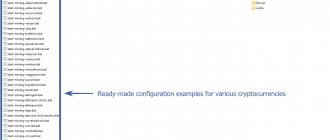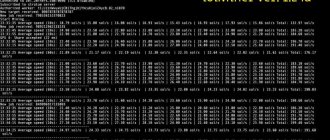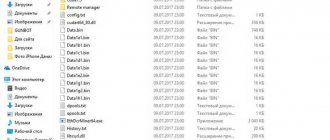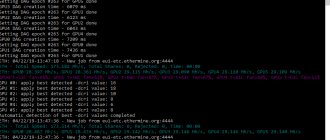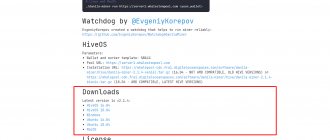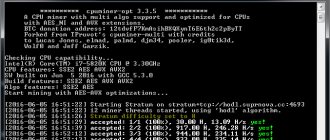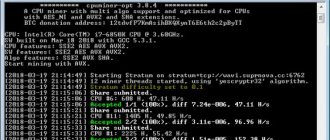T-Rex miner is a program for mining on video cards with support for a large number of algorithms. The code is posted on GitHub, which inspires confidence in the miner. There on the page the developers express their thoughts and views on the future of the project. There are plans to improve performance taking into account the equipment used. The T-Rex miner itself is created for green video cards, that is, Nvidia. For those who have not come across the concept, this is equipment with a chipset from Nvidia. In 90% of cases, cards from this particular manufacturer are used by domestic miners. The system supports Windows and Linux, which makes it even more worth paying attention to the program.
The miner development team is doing everything possible to keep the miner up to date with the latest algorithms, implementing new features requested by the miner community, including unique ones such as automatic updates and remote control of the miner via HTTP API, as well as ensuring that the miner was very stable. and is capable of supporting your GPUs 24/7.
What's new in T-Rex v0.20.0?
- Removed old and rarely used algorithms (x25x, x16r, etc.)
- Merged all CUDA builds into one binary
- (Windows) Added --pl, --mclock, and --cclock options to control GPU power limiting, memory clock, and core clock.
- (UI) Display maximum share difficulty if --validate-share is specified
- (Windows) Remove dependency on the Visual C++ runtime.
Error correction:
- --script-epoch-change - does not execute script when switching to ZIL session when dual mining ETH + ZIL (API)
- Inconsistent GPU order in API when --pci-indexing is set Various stability issues
Latest updates
Version – 0.21.6
- (Windows) Added additional minimum/maximum fan speed restrictions in automatic fan mode (see --fan for information)
- (API) Added a time stamp for the last submitted share (last_submit_ts)
- fix: (autolykos2) Improved compatibility with mining pools
- fix: The --worker command line option does not take precedence over what is specified in the configuration file
- fix: (API) Pausing the miner via HTTP POST does not work
- fix: --fork-at functionality broken
- fix: Cosmetic UI fixes
Version – 0.21.5
- (Linux) Added GPU power limit manager (see --pl parameter for info)
- fix:(autolykos2) Ball duplication problem
- fix:(Windows) Overclock the fan to 100% in auto-fan mode if the GPU temperature is much higher than the target temperature
- fix:(Web UI) watchdog-exit-mode parameter missing from configuration
Version – 0.21.4
- (autolykos2) Minor performance improvements (mainly for Pascal GPUs)
- (Windows) Increase fan speed to 100% in automatic mode
- fix:(autolykos2) Incorrect shares when mining ERGO on NiceHash
- fix:(mtp) ntime out of range and Low difficulty share errors
Version – 0.21.3
- fix:(autolykos2) Low hashrate on the pool side when mining ERGO on Nanopool
Version – 0.21.2
- fix:(autolykos2) Low hashrate on the pool side due to invalid shares
Version – 0.21.1
- fix:(autolykos2) Low hashrate on the pool side due to unnecessary creation of data sets
- fix:(autolykos2) High CPU usage in some configurations
- fix:(Windows) Fan speed settings were not reset when exiting the miner
- fix:(Windows) The system froze after turning off the miner if overclocking settings are applied with -cclock or -mclock
Version – 0.21.0
- Added autolykos2 algorithm for mining ERGO (dev fee 2%).
- (Windows) Display memory junction temperature if available (can also be used with auto-fan, see --fan for details)
- fix:(Windows) Overclock settings are not restored if the miner terminal is closed by pressing the X button
- fix: Total power consumption is not displayed if some GPUs do not report it. (#516)
Setting up the T-Rex
- Right-click on the file and select “Edit”.
- A text document will open and you will see a list of program commands. The -u key is responsible for the digital wallet address. It needs to be replaced.
- However, for those who are interested in fully customizing the program, let’s look at the contents of the batch file in more detail.
- t-rex - the name of the program that will be launched using the .bat file
- -a bcd — name of the mined coin algorithm. The list of available algorithms is listed above
- -o stratum+tcp://eu.icemining.ca — specify the pool address. The -o stratum+tcp:// construction is required
- :8433 — after the pool address we put a colon and indicate the pool port
- -u 1Gо7d8C1EYQzmgbsDkTSdtW2g5H5G3gBCo — after the -u key we indicate the address of your digital wallet
- -pc=BCD — specify the token of the mined coin. This is necessary for the pool to understand what coin we want to mine.
- -i 20 — set the intensity of the program
To run T-Rex with the configuration file config.txt, type in the console: t-rex -c config.txt. Use the config_example file as a starting point to create your own configuration. If the parameter is set in the configuration file and also via the cmd line, the latter takes precedence, for example: t-rex -c config.txt -w. You can also use environment variables: just put %YOUR_ENV_VAR% anywhere in your configuration file and it will be automatically replaced by the value of YOUR_ENV_VAR variable at runtime.
Miner configuration for HiveOS
Miner name- t-rex
Hash algorithm – select the algorithm that T-Rex supports (equivalent to -a argument)
Wallet and worker template - put Wallet in HiveOS syntax (equivalent to -u argument)
Pool URL - Place the pool URL here (equivalent to -o argument). For failover servers, use one on each line, with the first server being the primary server. The pool URL may contain a protocol (for example stratum+tcp://).
Password - enter password here (equivalent to -p argument), put x if password is not required by pool
Launch of T-Rex
So, we have set up a program to mine the Bitcoid Diamond coin. By analogy, other coins are configured using other algorithms. We launch our batch file by double-clicking the mouse and see what the miner’s console window writes to us:
- Program version
- Installed driver version
- List of video cards available for mining
- The pool address that you specified in the batch file
- Wallet address that you indicated in the batch file
- Coin token or pool password. Pools rarely use a password, so in 90% of cases you need to specify a token
- The program configures a connection to the pool
- Authorization on the pool
- The intensity is set to 20. We set it in the batch file with the -i parameter
- Current block and network difficulty of the mined coin
- The total hashrate of your farm.
- Hashrate of one video card
- Video card temperature
- Electricity consumption
- Fan blade speed
- Efficiency Kh/Watt
At this point, setting up the program can be completed, but we move on to considering all possible commands.
Example of operation and description of values (Console)
After starting from the bat file, you will see a console with information about mining, let's take a closer look at it:
- Miner name, current version and platform
- Current video card driver version
- Number of video cards recognized and ready for mining
- Algorithm and what the developer's commission is
- URL of the pool we connected to, USER is our wallet, PASS the pool password, WRK the name of our farm
- Information about connecting to the pool, if you see Authorized successfully, then everything is fine, if not, double-check the bat file settings
- Current ETH era, blocks we are participating in and difficulty
- Name of the video card and intensity (roughly speaking, overclocking). By default, the miner sets the optimal intensity; anything above 23 may well worsen the hashrate.
- Information about the successful generation of the DAG file and how much memory is left
Also, during the mining process you will see the following messages:
- Current date and time
- Where is mining and difficulty?
- Name of the video card, hashrate T-temperature of the video card; P-energy consumption (Watts); F-card fan speed; E-efficiency (hashrate) per watt (current hashrate/P(watts)).
- Number of balls per minute
- Information about the elapsed time since switching on
- Similar information as in p5, but also the number of solved balls
- Current information about era, block and difficulty
Launch examples:
- ETH+ZIL-shardpool
t-rex -a ethash -o stratum+tcp://eu1-zil.shardpool.io:3333 -u 0x1f75eccd8fbddf057495b96669ac15f8e296c2cd -p4444 -w rig0 —extra-dag-epoch 0
- ETC-2miners
t-rex -a etchash -o stratum+tcp://etc.2miners.com:1010 -u 0xa0192299ab3698d15db49e3cd460C780cf6C7ba8 -px -w rig0
- ETC-woolypooly
t-rex -a etchash -o stratum+tcp://etc.woolypooly.com:35000 -u 0xa0192299ab3698d15db49e3cd460C780cf6C7ba8 -px -w rig0
- ETH-2miners
t-rex -a ethash -o stratum+tcp://eth.2miners.com:2020 -u 0xa0192299ab3698d15db49e3cd460C780cf6C7ba8 -px -w rig0
- ETH-ethproxy
t-rex -a ethash -o stratum+https://127.0.0.1:8080
- ETH-nanopool
t-rex -a ethash -o stratum+tcp://eth-eu1.nanopool.org:9999 -u 0xa0192299ab3698d15db49e3cd460C780cf6C7ba8.rig0/ [email protected] -px
- ETH-ethermine
t-rex -a ethash -o stratum+tcp://eu1.ethermine.org:4444 -u 0xa0192299ab3698d15db49e3cd460C780cf6C7ba8 -px -w rig0
- ETH-miningpoolhub
t-rex -a ethash -o stratum2+tcp://europe.ethash-hub.miningpoolhub.com:20535 -u somaton.gtx1080 -px
- ETH-miningrigrentals
t-rex -a ethash -o stratum+tcp://eu-ru01.miningrigrentals.com:3344 -u wasya89.165854 -px
- ETH-woolypooly
t-rex -a ethash -o stratum+tcp://eth.woolypooly.com:3096 -u 0xa0192299ab3698d15db49e3cd460C780cf6C7ba8 -px -w rig0
- ETH-flexpool
t-rex -a ethash -o stratum+ssl://eth-us-east.flexpool.io:5555 -u 0xa0192299ab3698d15db49e3cd460C780cf6C7ba8 -px -w rig0
- CFX-woolypooly
t-rex -a octopus -o stratum+tcp://cfx.woolypooly.com:3094 -u 0xa0192299ab3698d15db49e3cd460C780cf6C7ba8.rig0 -px
- CFX-nanopool
t-rex -a octopus -o stratum+tcp://cfx-eu1.nanopool.org:17777 -u 0x100851451584c1e808fde4a2d077dd81129b2555.rig0/ [email protected] -px
- RVN-2miners
t-rex -a kawpow -o stratum+tcp://rvn.2miners.com:6060 -u RBX3G6nYDMHVtyaZiQWySMZwlBb2D23DpT8.rig -px
- RVN-ravenminer
t-rex -a kawpow -o stratum+tcp://stratum.ravenminer.com:3838 -u RBX3G6nYDgHVtyaZiQWySMZw1Bb2DEDpT8.rig -px
- RVN-woolypooly
t-rex -a kawpow -o stratum+tcp://rvn.woolypooly.com:55555 -u RBX3G6nYDMHVtyaZiQWySMZ56Bb2DEDpT8.rig -px
- SERO-woolypooly
t-rex -a progpow —coin sero -o stratum+tcp://sero.woolypooly.com:8008 -u JCbZnEb8XtWV814QWRpDcDxpQpXZXw4ARneAtwXNYdd3reuo4xQDcuZivopA761QnQyfMermHR9Mpi156F5n7ez932v75Wt7 vWbHXtuyZsQVWLbKNHnZgwcXbdyZmbw89WT -px -w rig0
- VEIL-woolypooly
t-rex -a progpow-veil -o stratum+tcp://veil.woolypooly.com:3098 -u bv2qzftzrvu2qa82zy29avylv8sclskweqsrwysgrkg -px -w rig0
- XZC-2miners
t-rex -a mtp -o stratum+tcp://xzc.2miners.com:8080 -u aBR3GY8eBKvEwjrVgNgSWZsteJPpFDqm6U.rig0 -px
- XZC-mintpond
t-rex -a mtp -o stratum+ssl://zcoin.mintpond.com:3005 -u aBR3GY8eBKvEwjrVgNgoWZsteJPpFDqm6U.rig0 -px
- XZC-woolypooly
t-rex -a mtp -o stratum+tcp://zcoin.woolypooly.com:3080 -u aBR3jY8eBKvEwjrVgNgSWZsteJPpFDqm6U.rig0 -px
What algorithms does the program support?
T-Rex miner will allow you to use 2 really very common and popular algorithms: x16rv2 and MTP. The first uses the future coin Ravencoin, and the second allows you to mine Zcoin. Thus, the developers provide excellent help to novice miners.
All algorithms
- etchash
- polytimos
- geek
- octopus
- phi
- sonoa
- mtp
- x16s
- x16rv2
- sha256t
- C11
- x21s
- x25x
- X22i
- x11r
- x16s
- x16rt
- x17
- timetravel
- progpow
- tensority
- skunk
- balloon
- dedal
- progpow-veriblock
- tribus
- etchash
- bitcore
- ethash
- bcd
- progpow-veil
- renesis
- lyra2z
- hmq1725
- honeycomb
- kawpow
- progpowz
- sha256q
- GLT algos: astralhash, jeonghash, padihash, pawelhash
The most profitable algorithms, at the time of writing, altcoins:
- Ravencoin (RVN) hash algorithm X16R;
- Zcoin (XZC)MTP;
- HelpTheHomeless (HTH) X16R;
- Gincoin (GIN) X16RT;
- SUQA (SUQA) X22i.
Here are the results for mining Zcoin XZC using the MTP algorithm:
| Nvidia GTX 1060 6gb | 1.6 |
| Nvidia GTX 1070 8gb | 2.1 |
| Nvidia GTX 1070Ti 8gb | 2.65 |
| Nvidia GTX 1080 8gb | 3 |
| Nvidia GTX 1080Ti 11gb | 3.65 |
| Nvidia GTX 1660 6gb | 1.5 |
| Nvidia GTX 1660Ti 6gb | 2.3 |
| Nvidia RTX 2060 6gb | 2.1 |
| Nvidia RTX 2070 8gb | 2.6 |
| Nvidia RTX 2080 8gb | 3.5 |
| Nvidia RTX 2080Ti 11gb | 4.3 |
Even more profitable projects may arise tomorrow. Developers periodically release new versions of software with wider functionality. It is necessary to regularly monitor the network, observing the prices of cryptocurrencies and the emergence of new blockchain assets. But you don’t have to worry about updating the miner; the t rex program has a built-in auto-updates function.
Watchdog
Watchdog is designed to monitor the state of the miner and restart the T-Rex if it crashes or freezes for any reason. In addition, the watchdog can optionally perform automatic updates if a newer version is available. We recommend using a watchdog to avoid mining downtime and ensure your GPUs are busy 24/7. If you really need to disable the watchdog, you can do so using the --no-watchdog option.
Advantages of the program
What else can be highlighted as an obvious benefit? Support for more than 30 algorithms. Thus, mining becomes universal. Perhaps this is the first universal mining program created for the domestic market with its own page on GitHub, that is, open source. Comfortable, honest, versatile. And support will definitely not refuse just because you speak English poorly or don’t speak it at all. Those who mined at the very beginning of the era understand.
The commission for using TRexminer is 1%. The developers charge it. Considering that such a board is installed for almost all algorithms, a domestic miner using the T-Rex miner is in more favorable conditions. The exception is the Tensority algorithm with a commission of 3%. In general, if every 2 hours the equipment runs for just over a minute per program, then the conditions are very favorable.
Other advantages include the following characteristics:
- t-rex miner can be downloaded in the public domain.
- Setting up t-rexminer does not require professional knowledge.
- Progressive work algorithms.
- Open access code.
- Simple interface.
- Maximum parameters for tracking.
- Work with any pools.
- Favorable reward.
- Using the program, anyone can become a miner. t-rex miner independently makes the connection and monitors operating parameters. You need to purchase a video card and join the pool. The miner will do the rest himself.
T-Rex miner is positioned as a program for the user, promising the implementation of functions requested by the community itself. Among the innovations already introduced into the program are automatic updates, remote control via HTTP API, and online monitoring of GPU operation and compatibility 24 hours a day. These advantages make mining accessible even to dummies, and the latest update also guarantees security, which is very important for mining on video cards.
Antivirus warnings
To protect the miner from reverse engineering attacks, the binaries are packaged using third-party software that corrupts the original machine code. As a result, some antivirus engines can detect certain signatures in the executable file that are similar to those of real viruses protected by the same packager. In any case, it is recommended not to use cryptocurrency miners on computers where you store your sensitive data (wallets, passwords, etc.).
IMPORTANT! This program is intended for advanced users (users should be able to manage AV/Firewall exceptions). Some of its components may be flagged by antivirus software, usually flagged by antivirus software. This is normal as almost all cryptocurrency and mining software on the market is AV blacklisted. Just make an exception in your AV software for the program to work correctly. This software is provided by its developers "as is", the site administration is not responsible for the risks associated with its use on your system, if you do not trust the developers of this software, do not use it.
Unpacking the archive (Install)
First, you need to unpack the contents of the archive into a folder. It is best if the folder is located on the C:\ drive and there are no Cyrillic characters in the full path to the folder. For example, you can place it in C:\Trexminer
The miner itself consists of several main files
- miner itself t-rex.exe
- bat file with mining settings
- README.md file, with a description of all settings from the developers
Please note that the .exe file must be located in the same folder as the bat file, and the miner itself is launched from the .bat file.
As a result, you will see all the miner files, including ready-made examples of .bat files
Adviсe
To maximize hashrate, our software uses all available GPU resources, so it is important that you check your overclock settings before you start mining. Our general recommendation is to start with the standard GPU settings (no overclock, default power limit) and then, once you're sure it's stable, slowly increase the overclock to find the "sweet spot" where the miner performs best and still fails . crash.
GPU fine tuning (Windows only)
All options can be set to a comma separated list to apply different values to different cards. (default value for all options: 0 — not used)
—fan Sets GPU fan speed in percent or target temperature (auto-fan).
—fan N (where N is the fan speed)
—fan t:N (where N is the target temperature)
Example: —fan 45,t:67 GPU #0: set fan speed to 45% GPU #1: maintain GPU core temperature at 67C Note: fan speeds are limited to [5%, 95%] range in auto-fan mode.
—pl Sets GPU power limit in percent. Must be within [0, 100] range.
—cclock Sets GPU core clock offset in MHz. Requires running the miner with administrative privileges. Will be set to 0 on exit and during DAG rebuild.
—mclock Sets GPU memory clock offset in MHz. Requires running the miner with administrative privileges. Will be set to 0 on exit and during DAG rebuild.
—cv Sets GPU core voltage in percent. Must be within [0, 100] range. Use it only in case you know what you are doing! Requires running the miner with administrative privileges.
--lock-cv Specifies desired GPU core voltage in mV. (default: 0 — disabled). Requires running the miner with administrative privileges.
—pstate Sets GPU P-state. Valid values: p0. Requires running the miner with administrative privileges.
—version Display version information and exit.
-h, --help Display this help text and exit.
Source
Using the T-Rex Command Line
Full list of command line options:
-a, --algo Specify the hash algorithm to use. etchash ethash kawpow mtp mtp-tcr multi octopus progpow progpow-veil progpow-veriblock progpowz tensority —coin [Ethash, ProgPOW] Set coin name. Helps avoid DAG rebuilds when switching back from a dev fee session. Example: “eth” for Ethereum, “zil” for Zilliqa. --extra-dag-epoch Allocate extra DAG at GPU for specified epoch. Can be useful for dual mining of coins like Zilliqa (ZIL). (eg: --extra-dag-epoch 0) --nonce-start [Ethash, ProgPOW] Starting nonce for the solution search. --nonce-range-size [Ethash, ProgPOW] Nonce range size for nonce search. The range will be split between all devices. -d, --devices Comma separated list of CUDA devices to use. Device IDs start counting from 0. —pci-indexing Sort devices by PCI bus ID. Device IDs start with 0. --ab-indexing Afterburner indexing (same as --pci-indexing but starts from 1). -i, --intensity GPU intensity 8-25 (default: auto). Controls the GPU workload size, in other words how many nonces the miner is processing “in one go”: N = 2 ^ intensity —low-load Low load mode (default: 0). 1 — enabled, 0 — disabled. Reduces the load on the GPUs if possible. Can be set to a comma separated string to enable the mode for a subset of the GPU list (eg: --low-load 0,0,1,0) --kernel [Ethash] Choose CUDA kernel (default: 0). Range from 0 to 5. Set to 0 to enable auto-tuning: the miner will benchmark each kernel and select the fastest. Can be set to a comma separated list to apply different values to different cards. (eg: --kernel 2,1,1,3) The support for this parameter may later be extended to cover other algorithms. --gpu-init-mode Enables DAG sequential initialization (default: 0). 0 — all GPUs are initialized in parallel 1 — fully sequential initialization, one GPU at a time 2 — two GPUs at a time etc. --dag-build-mode [Ethash, ProgPOW, Octopus] Controls how DAG is built (default: 0). 0 — auto (miner will choose the most appropriate mode based on the GPU model) 1 — default (suitable for most graphics cards) 2 — recommended for 30xx cards to prevent invalid shares Can be set to a comma separated list to apply different values to different cards. (eg: --dag-build-mode 1,1,2,1) --keep-gpu-busy Continue mining even in case of connection loss. -o, --url URL of the mining pool in the following format: ://: Supported schemes: stratum+tcp stratum+ssl stratum+http stratum2+tcp stratum2+ssl stratum2 is normally used by Nicehash, MiningPoolHub and other similar mining pools Example: stratum+tcp://eu1.ethermine.org:4444 stratum+ssl://zcoin.mintpond.com:3005 stratum2+tcp://daggerhashimoto.hk.nicehash.com:3353 -u, --user Username for mining server. -p, --pass Password for mining server. -w, --worker Worker name. -r, --retries Number of times to retry if a network call fails. -R, --retry-pause Pause in seconds between retries. -T, --timeout Network timeout, in seconds (default: 300) --time-limit Miner shutdown interval in seconds. (default: 0 — disabled) —temperature-color Set temperature color for GPUs stat. Example: 55.65 — it means that temperatures above 55 will have yellow color, above 65 — red color. (default: 67.77) —temperature-limit GPU shutdown temperature. (default: 0 — disabled) —temperature-start GPU temperature to enable card after disable. (default: 0 — disabled) -b, --api-bind-telnet IP:port for the miner API via telnet (default: 127.0.0.1:4068). Set to 0 to disable. For external access set IP to 0.0.0.0, in which case setting “—api-read-only” is recommended as well. —api-bind-http IP:port for the miner API via HTTP (default: 127.0.0.1:4067). Set to 0 to disable. For external access set IP to 0.0.0.0, in which case setting “—api-read-only” is recommended as well. --api-read-only Allow only read operations for API calls. -J --json-response Telnet API server will make json responses. -N, --hashrate-avr Sliding window length in seconds used to compute average hashrate (default: 60). --sharerate-avr Sliding window length in seconds used to compute sharerate (default: 600). --gpu-report-interval GPU stats report frequency. Minimum is 5 sec. (default: 30 sec) —gpu-report-interval-s GPU stats report frequency in shares. 0 by default (disabled). -q, --quiet Quiet mode. No GPU stats at all. --hide-date Don't show date in console. --send-stales Don't drop stale shares. --validate-shares Validate shares before sending to a pool. Also enables share diff info. --no-color Disable color output for console. --no-hashrate-report Disable hashrate report to pool. --no-nvml Disable NVML GPU stats. --no-strict-ssl Disable certificate validation for SSL connections. —no-watchdog Disable built-in watchdog. --watchdog-exit-mode Specifies the action "A" the watchdog should take if the miner gets restarted "N" times within "M" minutes. Format: N:M:A. Valid values: N: any positive integer, M: any positive integer, A: r(system reboot), s(system shutdown), e(miner exit) Actions “r” and “s” require running the miner with administrative privileges. Examples: 20:10:s — watchdog will shutdown the system if the miner gets restarted 20 times within any 10 minute interval 5:7:r — watchdog will reboot the system if the miner gets restarted 5 times within any 7 minute interval -B , --benchmark Benchmark mode. --benchmark-epoch Epoch number used during benchmark (only for algorithms that generate DAG). -P, --protocol-dump User protocol logging. -c, --config Load a JSON-format configuration file. -l, --log-path Full path of the log file. --cpu-priority Set process priority (default: 2) 0 idle, 2 normal to 5 highest. --autoupdate Perform auto update whenever a newer version of the miner is available. --back-to-main-pool-sec Forces miner to switch back to main pool in case working with failover pool. Parameter is set in seconds. (default: 600) —exit-on-cuda-error Forces miner to immediately exit on CUDA error. --exit-on-connection-lost Forces miner to immediately exit on connection lost. --reconnect-on-fail-shares Forces miner to immediately reconnect to pool on N successively failed shares (default: 10). --fork-at Forces miner to change algorithm on predefined condition (works only with built-in watchdog enabled) Epoch condition: =epoch: (eg: --fork-at etchash=epoch:390). Block condition: =block: (eg: --fork-at x16rv2=block:6526421). Time condition: =time:. Time must be set in UTC+0. (eg: --fork-at x16rv2=time:2019-10-01T16:00:00). To change main pool port you must write it right after algo: : (eg: --fork-at x16rv2:4081=time:2019-10-01T16:00:00). —mt Memory tweak mode (default: 0 — disabled). Range from 0 to 6. General recommendation is to start with 1, and then increase only if the GPU is stable. The effect is similar to that of ETHlargementPill. Supported on Pascal GPUs with GDDR5 or GDDR5X memory only. Requires running the miner with administrative privileges. Can be set to a comma separated list to apply different values to different cards. Example: —mt 4 (applies tweak mode #4 to all cards that support this functionality) —mt 3,3,3,0 (applies tweak mode #3 to all cards except the last one) —script-start Executes user script right after miner start (eg: --script-start path_to_user_script) --script-exit Executes user script right before miner exit. --script-epoch-change Executes user script on epoch change. --script-crash Executes user script in case of miner crash. --script-low-hash Executes user script in case of low hash. Hash threshold is set in MegaHashes/second. Example: --script-low-hash script_to_activate:50 (activates "script_to_activate" script once total hashrate drops to 50MH/s) --version Display version information and exit. -h, --help Display this help text and exit. —————— GPU fine tuning for Windows only —————— All options can be set to a comma separated list to apply different values to different cards. (default value for all options: 0 — not used) —fan Sets GPU fan speed in percent. Must be within [0, 100] range. —pl Sets GPU power limit in percent. Must be within [0, 100] range. —cclock Sets GPU core clock offset in MHz. Requires running the miner with administrative privileges. Will be set to 0 on exit and during DAG rebuild. —mclock Sets GPU memory clock offset in MHz. Requires running the miner with administrative privileges. Will be set to 0 on exit and during DAG rebuild.
Discord:
Bitcointalk:
This post is also available in: English
GPU fine tuning (Windows & Linux)
--lock-cclock Specifies desired locked GPU core clock speed in MHz. (default: 0 — disabled). Requires running the miner with administrative privileges. Example: --lock-cclock 1000 (applies clock 1000Mhz to all cards that support this functionality) --lock-cclock 1000,1300,0 (applies clock 1000Mhz to GPU #0, 1300MHz to GPU #1, ignore GPU #2)
—mt Memory tweak mode (default: 0 — disabled). Range from 0 to 6. General recommendation is to start with 1, and then increase only if the GPU is stable. The effect is similar to that of ETHlargementPill. Supported on Pascal GPUs with GDDR5 or GDDR5X memory only. Requires running the miner with administrative privileges. Can be set to a comma separated list to apply different values to different cards. Example: —mt 4 (applies tweak mode #4 to all cards that support this functionality) —mt 3,3,3,0 (applies tweak mode #3 to all cards except the last one)
